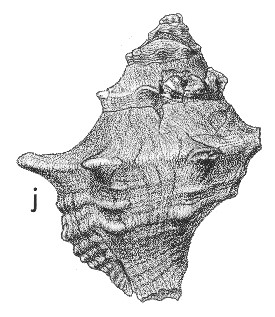
Revised descriptions of New Zealand Cenozoic Mollusca from Beu and Maxwell (1990)

 | Revised descriptions of New Zealand Cenozoic Mollusca from Beu and Maxwell (1990) | 
|
  (Pl. 30j): Tanglewood, Bideford, east of Masterton, Wairarapa, early Tongaporutuan (GNS; from a private collection) |
Beu & Maxwell (1990): Chapter 13; p. 264; pl. 30 j.
Synonymy: Fusus crawfordi Hutton 1873b, p. 3; Austrosipho (Verconella) latispinifer Marwick 1932, p. 501; Austrosipho masoni Fleming 1943, p. 201; Austrosipho takapauensis Fleming 1943, p. 202; Murex crawfordi; Verconella crawfordi; Austrosipho (Verconella) crawfordi; Verconella latispinifer
Classification: Buccinulidae
Description: Large for family (100-120 mm high, 70- 100 mm wide including nodules), with relatively short, conic spire (consistently only third to half height of aperture and canal), prominent angulation at half to lower third of whorl height on spire (or even lower on some specimens) that bears moderately large to exceedingly long (to 30 mm long in large specimens of the form latispinifer), dorso-ventrally compressed, round-tipped nodules, forming strongly concave sutural ramp. Sculpture of faint, irregular spiral threads on sutural ramp and between spiral cords around periphery, and several low, rounded, somewhat irregular spiral cords around periphery and on base; on most specimens, 1 major cord around peripheral nodules, 3 or 4 other prominent ones below (the lowest forming weak peribasal angulation with low nodules), and another 8-10 closer ones on neck and canal; below periphery, cords are irregularly nodulous and scaly because of relatively coarse, close, irregular growth ridges. Aperture oval, with thick, smooth lips and low parietal callus pad. Anterior canal relatively short and wide (very incomplete on figured specimen), curved weakly to left and then right, with wide, shallow pseudumbilical groove in many specimens. Protoconch not seen, presumably as in other Penion species, large and subcylindrical, of about 3 whorls, with a blunt apex.
Comparison: Penion crawfordi is extremely variable in spire height, the portion of the previous whorl hidden by the sutural ramp, the prominence of the spiral cords (particularly on the base) and, in particular, the length of the peripheral spine-like nodules. The nodules are very low and rounded in a few specimens, moderately large in most specimens, but enormously developed in the form latispinifer. Large collections, such as those from Hurupi Stream, Palliser Bay (Tongaporutuan) show that A. latispinifer, A. masoni and A. takapauensis are part of the variation of P. crawfordi. P. crawfordi was apparently the culmination of a lineage of progressively more short-spired, coarsely sculptured species that are common in shallow, soft-bottom facies throughout the New Zealand mid-Cenozoic; its presumed immediate ancestor is P. marwicki (Altonian; Pl. 20m), which is a little taller and narrower, has more even spiral sculpture, and has fairly consistent, small to medium-sized peripheral nodules. A possible relative is P. huttoni (Kapitean?-Opoitian, Awatere Valley), which has lower peripheral nodules, more even spiral sculpture, and no marked lower angulation on the last whorl, and so is perhaps an early member of the species group containing the living P. sulcatus (Pl. 49a).
Distribution: Clifdenian?; Lillburnian-Tongaporutuan; "Te Awaite, East Coast, Wellington", type of Fusus crawfordi (from a "Hurupi facies" faunule, early Tongaporutuan, in southern Wairarapa, and probably from Hurupi Stream area, Palliser Bay); Burnt Hill, near Oxford, North Canterbury, Waiauan (type of Austrosipho latispinifer); "Tutamoe formation", Takapau Survey District, southern Hawke's Bay, Lillburnian to Tongaporutuan? (type of Austrosipho masoni); Takapau Survey District, southern Hawke's Bay, Tongaporutuan (type of Austrosipho takapauensis ). Dell (1952, p. 78, fig. 9) illustrated Hutton's holotype of Fusus crawfordi. Widespread and common in near-shore sandstone with diverse Mollusca, in Gisborne district, southern Hawke's Bay, Wairarapa, Marlborough, North Canterbury, and at Fox River, Westland; common at some localities, such as Hurupi Stream.
Cite this publication as: "A.G. Beu and J.I. Raine (2009). Revised
descriptions of New Zealand Cenozoic Mollusca from Beu and Maxwell (1990). GNS
Science miscellaneous series no. 27."
© GNS Science, 2009
ISBN
978-0-478-19705-1
ISSN 1177-2441
(Included with a PDF facsimile file
copy of New Zealand Geological Survey Paleontological Bulletin 58 in CD version
from: Publications Officer, GNS Science, P.O. Box 30368 Lower Hutt, New
Zealand)